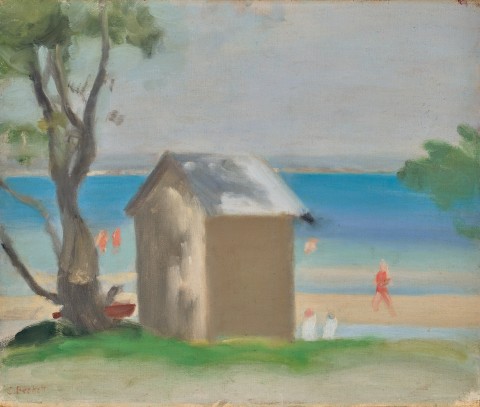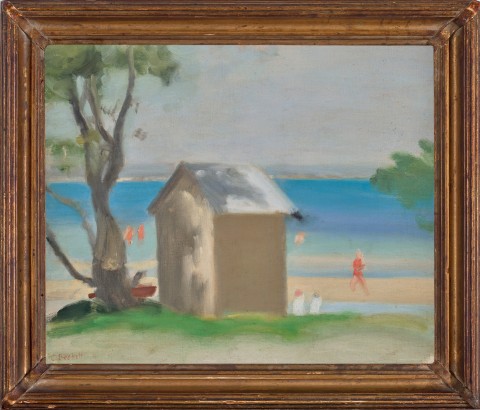THE SOLITARY BATHING BOX, c.1932
CLARICE BECKETT
oil on canvas on board
38.5 x 45.5 cm
signed lower left: C Beckett
bears inscription verso: “THE SOLITARY BATHING BOX” / BY CLARICE BECKETT. 10 guineas – / THE MELDRUM GALLERY / (J. H. MINOGUE) / 127 QUEEN ST / MELBOURNE
Private collection
L.J. Cook and Company Pty. Ltd., Melbourne
Private collection, Melbourne, acquired from the above on 30 June 1998
Probably: Exhibition of Paintings by Clarice Beckett, The Meldrum Gallery, Melbourne, 28 November – 9 December 1933
Clarice Beckett: Politically Incorrect, The Ian Potter Museum of Art, The University of Melbourne, Melbourne; SH Ervin Gallery (National Trust of Australia), Sydney; Orange Regional Gallery, New South Wales; Art Gallery of South Australia, Adelaide; Bendigo Art Gallery, Victoria; Tasmanian Museum and Art Gallery, Hobart; Burnie Regional Art Gallery, Tasmania, 5 February 1999 – 22 May 2000 (label attached verso)
Hollinrake, R., Clarice Beckett: Politically Incorrect, The Ian Potter Museum of Art, The University of Melbourne, Melbourne, 1999, cat. 65, p. 76
We are grateful to Rosalind Hollinrake for her assistance with this catalogue entry.
For nearly four decades, the paintings of Clarice Beckett vanished from public view and it was not until the gallerist, Ros Hollinrake, mounted a series of ground-breaking exhibitions from 1971 that this omission began to change. An early visitor to the first show was the painter Fred Williams, who then encouraged the National Gallery of Australia’s inaugural director James Mollison to follow suit. Equally impressed by what he saw, Mollison purchased eight paintings for the national collection, and Beckett’s fame has since increased to such an extent that almost every one of the country’s major institutions now owns examples of her work. She was, in the words of Germaine Greer, ‘the first artist to paint the suburbs of Australia… Australia as it really is, as we know it’;1 whilst the artist Sir William Dargie considered her to be ‘a pure and perfect artist in her own way, one of the finest ever to work in Australia.’2
Beckett famously studied for a short period under the theorist Max Meldrum who expounded his theory of the ‘Science of Appearances’, but hers was a talent which would not be shackled to such rigid rules. She read widely and was a committed attendee to lectures regarding Theosophy and Buddhism. On top of her prior training at the National Gallery School under Fred McCubbin, Beckett’s combined talents saw her transcend the work of Meldrum who, for example, abhorred too much colour, an opinion in stark contrast to the radiant hues in paintings by Beckett such as The Solitary Bathing Box, c.1932. She was a prolific artist who used flat brushwork and thin paint that was smoothed into the canvas, a technique Hollinrake once described as being ‘really healthy. It’s paint you want to touch… They have that glow.’3 Others recognised a moody haze akin to Whistler, whilst Beckett herself talked of the ‘musicality’ her works projected. In all her paintings – undeniably – is an enveloping atmosphere of tranquillity that underscores an equal sense of spontaneity, of a snapshot quickly taken before the subject is even aware.
Although she travelled much within Victoria, Beckett’s home base was Beaumaris on Port Phillip Bay and she painted the region ceaselessly. Resisting her colleague’s suggestions that she should travel abroad, she argued that ‘I have only just got the hang of painting Beaumaris after all these years, why should I go somewhere else strange to paint?’4 Numbers of these bathing huts were clustered on the foreshore during Beckett’s lifetime, but many were destroyed through a series of tremendous storms starting at the end of 1934. As such, it is hard to exactly situate the subject of The Solitary Bathing Box but its outlook on the long expanse of the Mentone cliffs with the hint of a headland to the left suggests that it may have been sited at her local beach on Watkin’s Bay. The hazy summer sky and the jaunty red bathing suit of the striding figure indicates a hot, sunny day - the colours of which radiate through the waters to the right of the hut, painted by Beckett in striking bands of violet, blue and soft ochre.
1. Germaine Greer, quoted in Smee, S., ‘Painter put her soul into suburbia’, Sydney Morning Herald, 24 April 1999, p. 5
2. Dargie, Sir W., ‘Introduction’ in Homage to Clarice Beckett (1887-1935): idylls of Melbourne and Beaumaris, Rosalind Humphries Galleries, Melbourne, 1971
3. Rosalind Hollinrake, quoted in Smee, S., ibid.
4. Clarice Beckett, quoted in Hollinrake, R., Clarice Beckett: the artist and her circle, Macmillan, Melbourne, 1979, p.21
ANDREW GAYNOR

